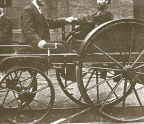
From the early 1840s railways had challenged, and then superseded, Britain’s inland waterways, offering higher speed, greater freight-carrying capacity and disciplined, waged, workforces. There were only rare examples of rail and canal working together to service the transport needs of the world’s first fully industrialised nation; they competed, nearly always to the detriment of the waterways. But competition very soon led to acquisition... A. J. MULLAY explains.
Spying in Darlington is not what might be expected of canal owners from Birmingham. But in January 1826 the directors of the Birmingham Canal Navigations decided to send one of their number to County Durham “to inspect the state of the Railroad laid down there, and ascertain how far the operation of Locomotive Steam Engines answers the purposes laid out...”
The ‘railroad’ referred to was of course the Stockton & Darlington, differing from those railways already in existence in that it had broken out from a localised site such as a colliery and now connected distant towns, and was handling both goods and passengers. However, soon the board of directors would not have to send their representatives so far to see railways at work; before long the ‘Iron Road’ could be seen serving in an inter-city role much closer to Birmingham – between Liverpool and Manchester. It was to be the beginning of a commercial rivalry between railway and waterway, two very unequal opponents; rivalry which often resulted in the former owning the latter.
Canal ownership by railway companies has often come as a surprise even to the most avid of waterway enthusiasts, among whom author and publisher Robert Aickman can certainly be counted – he became the first chairman of the Inland Waterways Association – and he wrote later of how he first came across this aspect of canal ownership while walking along the Stratford Canal between shows at the then-new Shakespeare Memorial Theatre.
“Everywhere there were threatening notices, all stamped out on iron plates, and all in the name of the Great Western Railway. I was at a loss to understand how the GWR could come into the scene at all. In its proper place, I loved and revered the GWR Company almost as much as anyone... but all these black, iron, notices were depressing and frightening.”
In fact, railway companies had soon overwhelmed their transport predecessors, benefiting from the established expertise of a new community of canal-trained surveyors and engineers, buying waterways, often for their routes, and if not, purchasing their toll powers which could then be manipulated (invariably raised) so as to price the canals concerned ‘out of the market’.
Examples abound of canals selling out to railway companies in a manner which suggested a resigned recognition that the railway could carry goods and passengers many times faster and in greater quantity than transport by water. The owners of such ‘navigations’ as Carlisle’s and Croydon’s were happy to sell to a railway company needing to utilise the existing canal route (respectively the North British Railway and London & Croydon, a forerunner of the London, Brighton & South Coast Railway), while others, such as the Manchester, Bolton & Bury, actively planned to convert from water to rail themselves. There were even examples of canal owners who were prepared to enforce, through the courts if necessary, promised takeovers by railway, as at Tollington in Devon or Leominster, but also on such major routes as the Grantham and Nottingham waterways.
Even as early as 1848, with the concept of the main line railway less than 25 years old, the future appeared ominous for canal operators – and those who invested in them. When Robert Darwin died in November of that year, his children found themselves better off than they




